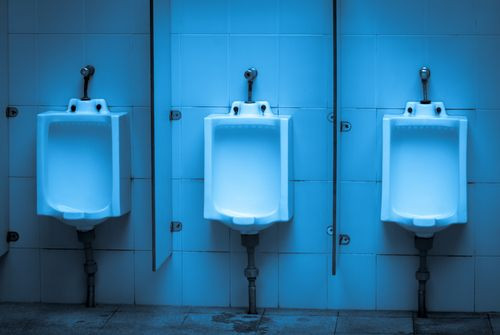Men With LUTS, Other Prostate Problems May Improve Urination By Sitting Down

Forget how it might bruise your ego; if sitting down on the toilet improves your ability to urinate comfortably because you suffer from a prostate condition, such as lower urinary tract symptoms (LUTS), there’s no shame in the act.
A new study in PLOS ONE finds that while sitting down offers men without such prostate issues no measurable benefit, men who suffer from LUTS are able to urinate faster, with greater force, and leave less urine behind in their bladders. These are all challenges men with the condition face, in addition to the rarer complications of urinary pain and excessive urination at night.
“Ever since men had the choice to urinate either standing or sitting, the optimal voiding position has been a topic of discussion,” write the researchers, of the Leiden University Medical Center in the Netherlands. Were our bodies designed to stay upright, or were we meant to submit to gravity and squat? Despite the comparable technology advances in the West, Eastern cultures have stayed loyal to the act of squatting. The modern toilet simply isn’t for everyone.
But whether it’s necessarily better isn’t all that understood. “Only a handful of studies have investigated the effects of voiding posture on urodynamic parameters by comparing the standing versus the sitting position,” the authors write (making terrific use of the phrase “urodynamic parameters”). So they conducted a meta-analysis, which is just about the least fun way to conduct a pee study.
From the 14 medical databases they looked at, from a total of 2,352 publications, 96 studies eventually got whittled down to the most viable 11. The findings were consistent across each study, despite slight differences in methodology and overall goal. “We found that in patients with LUTS the sitting position is associated with a trend towards a more favorable urodynamic profile,” they wrote. The profile confirmed each measure they hypothesized about: When men with LUTS sat down to urinate, they did so faster, longer, at a greater pressure, and released more urine than men with LUTS who stood.
The team offers several explanations. One is that older men typically succumb to prostate-related issues, and combined with the fear of falling is a hesitancy to go. Among younger subjects, however, this isn’t an issue. So the researchers proposed that the ease with which urination takes place while sitting is also a factor.
While standing, the body goes to great lengths to keep an erect spine and maintain posture. This activates many of the discrete muscles near the hips and pelvis. But when people sit, these pelvic and hip muscles are relaxed, making urination easier. “Furthermore,” the team writes, “contraction of the pelvic floor musculature inhibits the activity of the detrusor urinae muscle,” whose contraction is necessary for proper urinary function.
Or there’s the third explanation: You’re too embarrassed to pee because you’re afraid something else might happen. “The desire not to lose defecation or flatus in standing position, especially in public conveniences, can thus lead to increased activity of the pelvic floor musculature and consequently impaired micturition.”
So what’s the moral of the story? What you do in the privacy of a public bathroom stall is your own business. People have been sitting and squatting to urinate for far longer than they’ve been standing. And evolution rarely gets it wrong.
Source: de Jong Y, Pinckaers J, Brinck R, Nijeholt A, Dekkers O. Urinating Standing versus Sitting: Position Is of Influence in Men with Prostate Enlargement. A Systematic Review and Meta-Analysis. PLOS ONE. 2014.



























